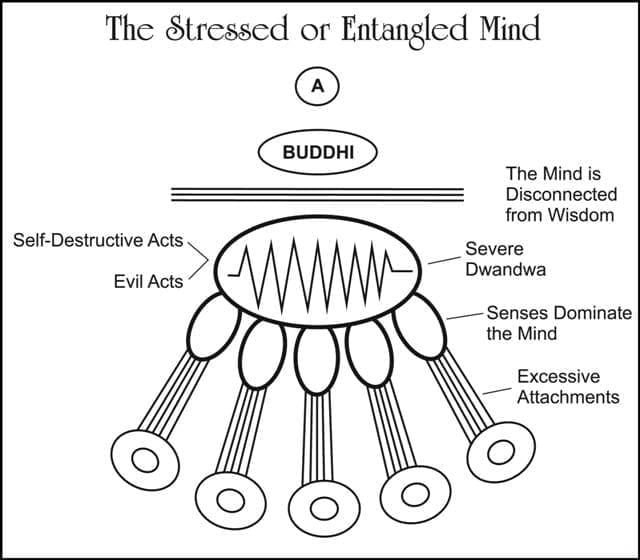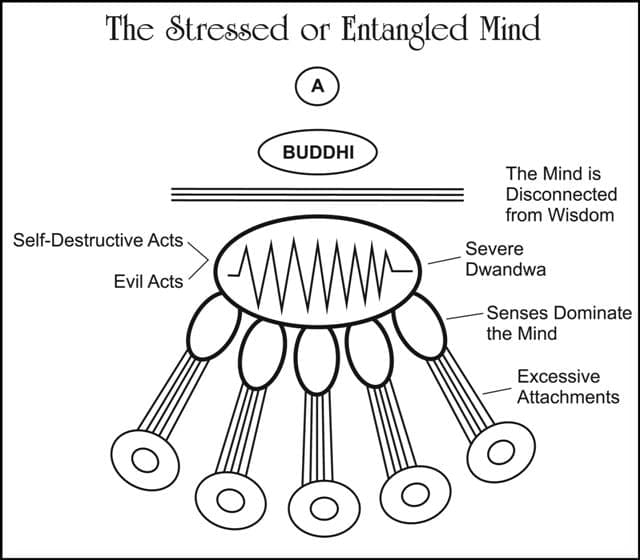
So, I was gifted a copy of the Gita by an acquaintance during my MBBS days in Jawaharlal Nehru Medical College (JNMC), Belgaum. I was probably 19 or 20 at that time,and was not that keen on reading the teachings of Krishna. After 10 years, while going through my library of some 3000 odd books,I stumbled on this copy and decided to give it a try. I’d been told that it was a good book to learn about management and stuff and on the threshold of getting married to the girl I loved, I decided to start reading the Bhagavad Gita.
To make any sense out of Bhagavad Gita‘s wisdom, one must be like an expert gemologist who sorts through 700 pieces of different stones lumped together in a jewelry box, separates them into rubies, diamonds, emeralds, sapphires, topaz, jade, marble, granite and the like, and uses some of them selectively and creatively to make proper jewelry.
Selfish Desire invariably leads to Possessiveness. Whereas Selfish Desire means hankering to have Sense Objects (people, money, title, material things, etc.), Possessiveness means hanging on to them, or being unable to let go of them. Possessiveness is an addiction. It often leads to Greed where the more one has the more he wants. Greed invariably leads to loss of judgment, and finally to Fraud in which one tries to get the desired objects by hook or by crook. During my time as a physician in a small town in Udupi district, there was no other single issue that came even close as Possessiveness in creating stress in the lives of my patients. The Gita makes this abundantly clear throughout the book.

Possessiveness creates in our mind a cascade of stressful emotions: insecurity, envy, jealousy, anger, greed, hate, rage, etc., all very toxic emotions that bring on changes in our brain chemicals leading to stress symptoms. To calm ourselves down, we become control freaks, just as we tend to hold a purse tighter when someone tries to snatch it from us. When we try to control others, conflict follows. Peace of mind and tranquility are destroyed.
Let us look at a few life scenarios: A middle-aged Indian woman is very possessive of her son, aged 35, older of her two children. When he got married to a girl from another religion, she became very distraught. She had hoped he would marry a girl of her choice (so she could control her too!). To counter his mother’s possessiveness, the son moved as far away as possible from her. Unable to let go of him and deal with her grief over losing him, she calls him often, sends him T-shirts, shorts and other stuff she buys on sale. Her son tells her, “Mom, don’t waste money on these things. I don’t wear them. I will buy over here what I want. I don’t wear anything my wife does not approve of.” This incensed the mother to no end. She often asks him to visit her. He says, “Mom, my wife has no vacation time left.” She says, “You come alone!” When he declines her offer, she becomes sad, hurt, disappointed and angry. She is perpetually stressed-out.
This woman’s possessiveness has blinded her to the fact that her son has a life of his own now and she better LET GO OF HIM! When it comes to our children, we can do only FOUR GOOD THINGS for them: GOOD FOOD for their Body; GOOD EDUCATION for their Mind; GOOD VALUES for their Soul, and GOODBYE for their Happiness! You have heard the well-worn cliché, “If you really love someone, you must let them go.”
Indian women (bless their hearts!), and quite often men as well, are especially possessive and controlling of their children. Their need to own their children, especially their sons, has a darker side which is very difficult for many Indians to admit: Widespread practice of emotional and physical torture of daughters-in-law. This obsessiveness takes many forms: preventing the daughter-in-law from talking with or sleeping with the son; intruding into the bed room when the couple are together; demanding to be taken with them when they are on honeymoon, or vacation; pitting one against the other, etc. Aside from suffering emotional torture silently, many daughters-in-law die from starvation, burning, beatings or suicide.
As a rule, the gutless sons, unable or unwilling to stop their possessive, control-freak mothers on account of their misguided sense of loyalty to them (“matthra devo bhava!”) fail to distinguish Dharma from Adharma, right action from wrong action (Gita: 18: 31), and quietly become party to this inhumanity against their wives whom they had sworn to protect, the fire God Agni as their witness. To me personally, the most disgusting part of being an Indian is the spinelessness displayed by grown up Indian “boys” with their parents in the face of overwhelming and obvious injustice perpetrated by their parents.
You see obsessiveness even among relatives. You are invited for dinner by a relative during your visit to your native.
You plead, “We have already met here, you know. No need for dinner.”
She insists, “How can that be? You have come after a long time. You must come for dinner.
You stick to your guns. She is disappointed, hurt, and angry. After she goes home she is full of venom against you, “He acts like a big shot just because he’s now become a Doctor! He acts differently now that he has money.
She did not have enough sense to say, “O. K. son. I would have been very happy if you came for dinner. Maybe next time.” That
would have been the end of the matter. No. The whole thing has to be a big production.
I can give you thousands of life stories like these, but I know you all get the idea what we are talking about. The whole of Bhagavad Gita is nothing but a guide for us to learn how to deal with this single most important issue at the root of all our misery and stress. What, then, is the solution according to Gita?
Gita’s answer is simple: Renounce and enjoy life. Cultivate desirelessness, non-possessive attitude in our thoughts, words and actions (manasaa, waacha, karya) through the discipline of Yoga. This is not the kind of Yoga the Urban public have in mind, the Yoga in which one twists his body into a kodbaLe, chakkuli or jalebi. This is not the fluffy Yoga we read about in Ladies’ Home Journal and Red Book: Hatayoga, Yogasanas and the like.
The type of Yoga Lord Krishna recommends in Bhagavad Gita is a whole different ball game. It is a discipline that teaches its regular practitioner how to detach himself from the fruits (karma, consequences) of his actions via a doctrine of Nishkama Karma; how to resist Selfish Desire (” like an unperturbed ocean in the face of a river entering it.” ); how to withdraw his Senses from Sense Objects (“as the turtle withdraws his limbs within the shell.” ); how to steady his Mind (“like a flame in the windless place.”) against the duality of pleasure and pain (“they appear and disappear like winter and summer seasons;learn to tolerate them.”); how to tap into the wisdom of his Intellect; and how to attain the absolute tranquility of Self (Atman).
In addition, Gita’s Yoga exhorts one to become more aware of the detrimental role of various toxic emotions and impulses in our mind such as Selfish Desire (Kama), Anger (Krodha), False Pride (Mada), Possessiveness (Moha), Greed (Lobha) and Jealousy (Matsarya), and to develop skills to control these before they destroy our peace of mind and ruin our lives.
Gita’s yoga urges the reader to practice Sacrifice to counter Possessiveness; Austerity to cancel-out False Pride; Penance to neutralize Sinful Actions, and Charity to negate Greed. Controlling one’s Demonic tendencies would lead him to Divinity ( tamaso ma jyothirgamaya ).The ultimate goal of Gita’s Yoga is to motivate us to become a Stithaprajnya, a person of Steady Awareness or Concentration or Wisdom; a person who is immune to life’s duality of ups and downs, happiness and sadness, success and failure, victory or defeat; a person who has attained absolute tranquility of Mind; a person whose Mind ( zone # 3 ) and Intellect ( zone # 2 ) have merged with his Self ( Atman ) ( zone # 1) through a life-long process of “self-realization.”

Brilliant.
Hi, Could u please City the source of this image? I remember seeing this image along with similar image (for mind, attachments, soul, etc) for noble souls. I would like to see that image again, but unfortunately I am no longer able to find this site again.
Got my answer
Slide 18 from bhagvad-gita-chapter-2-overview on Slideshare by medikumar7